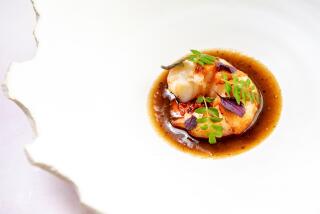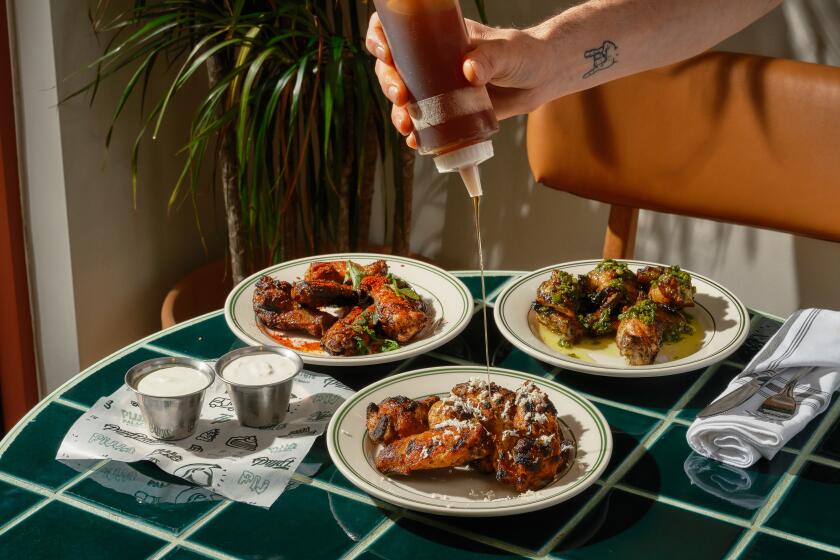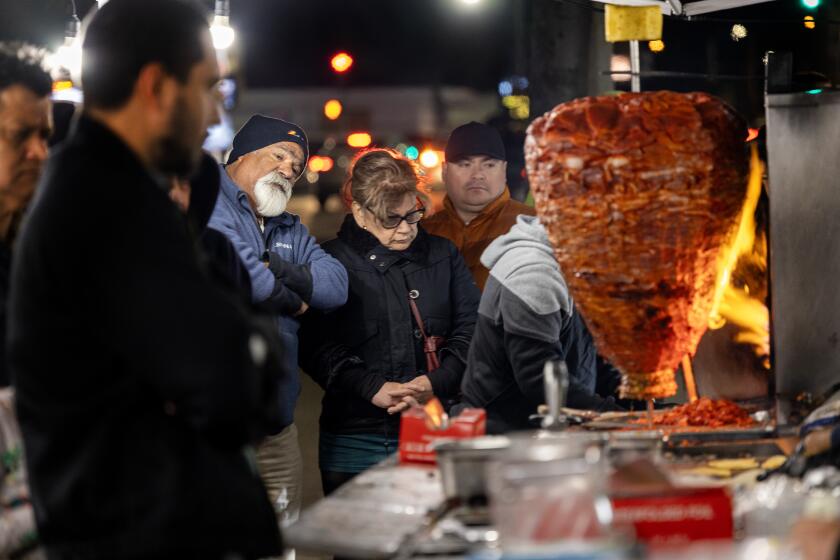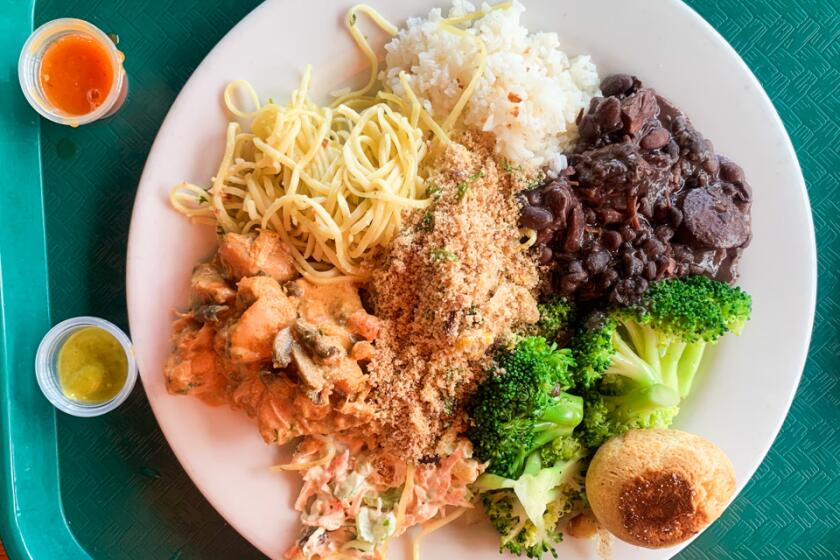National Restaurant Assn. Wine Classic Attracts European Vintners
Some of America’s leading restaurateurs, sommeliers, hoteliers and wine journalists judged more than 400 wines at the National Restaurant Assn. Wine Classic, a third-year wine competition, organized for the purpose of demystifying wine for consumers and restaurateurs.
The judging is held in a specifically constructed area, equipped for professional tasting in full view of the more than 100,000 visitors at the association’s annual restaurant show.
For the first time the competition included foreign wines such as French Beaujolais--Villages, 1985; German Riesling Kabinett, 1985 Portuguese Ruby Port, and Italian wines made from the Sangiovese grape, as well as American varietals, Cabernet Sauvignon, Marechal Foch and Johannisberg Riesling.
For the class of Johannisberg Riesling, Best of the Show award was given to Gold Medalist Navarro Vineyards, Late Harvest, 1984, a superb botrytized, full, rich luscious Johannisberg Riesling, with an incredible candied aroma.
Infected With Noble Rot
This is a complex wine of decidedly generous flavors suggesting a variety of fruit tastes--including pineapple, papaya and apricot--which was produced by sheer vintage luck because a major storm threatened and pickers were instructed to harvest the reverse of normal. Only clusters infected with the noble rot were selected while sorters discarded other so-called good but not affected grapes as undesirable. Available in 350 milliliters at $10 and $18.50 in full 750 milliliters.
Other Gold Medalists were Chateau St. Michelle, Reserve Late Harvest, 1984; Kendall Jackson Winery, Clear Lake, 1986; Rodney Strong, Select Late Harvest, 1985, and Sebastiani Vineyards, Late Harvest, Sonoma, 1985.
Raymond Vineyards, Private Reserve, 1982, captured Best of Show honors, a wine previously reviewed here and released recently at $16. It is a huge, robust wine with considerable backbone but showing some smoothness and a forward, ripe taste. Made from selected lots of estate Cabernet grapes, the wine by nature tends to be big, intensely flavored and given longer than customary barrel and bottle aging.
Other Gold Medalists are Glen Ellen, Estate, 1984; Maddalena, Sonoma Reserve, 1984 and Roudon-Smith, 1983.
French Hybrid Red Wine
A fascinating category was Marechal Foch, a French hybrid red wine developed principally in Alsace, which has become a kind of standard in those parts of American where vintage is governed by a short growing season such as on the East Coast, and in Canada. Best of show honors went to Gold Medalist, Wollersheim du Sac, 1985, from the state of Wisconsin, an area better known for cherry wine-producing wineries.
Produced at Prairie du Sac, Wis., by Robert Wolershiem, the wine was made at a 19th-Century stone winery with hillside caves, and vineyards which reportedly had once been owned by California’s father of viticulture, Count Agoston Haraszthy.
The count had settled in Wisconsin about 1840 and founded a town which he named, appropriately, Haraszthy but now known as Sauk City. Wollersheim believes grapes can grow as well in Wisconsin as in the Finger Lakes of New York and indeed his Gold Medal goes a long way to support his contention.
Other winners are Silver Medalist, Terra Wine Cellar, Terra Vineyard, Ill., 1985; Widmer’s Wine Cellars, Finger Lakes, 1983; and Bronze Medalist, 1985, Serendipity Cellars, Willamette Valley and Wollersheim Winery, Ruby Nouveau, 1986
Piesporter Goldtropfchen, J.B. Hain, 1985, was the Best of Show standout in the German Riesling Kabinett category. Kabinetts are generally produced from so-called normally ripe grapes and are the driest of the German wines with special designations. The wine coming off an excellent vintage showed a clean, fruity nose and taste, slightly sweet in ripe generous flavors.
All of the contestants here were from the 1985 vintage, including the other two Gold Medalists Winkeler, Hasenspring, Deinhard and Partners and Winningen Bruckstuck Spatlese, Richter-Paul Mann. Silver Medalists were Hocheimer Koenigin, Victoriaberg, Deinhard and Partners, Niersteiner Bildstock, Schieffelin; Schloss Johannisberg, Seagram’s Chateau and Estate Wines, and Schloss Vollrads, Rheingau, House of Burgundy.
Beaujolais Villages, also from the 1985 vintage, as a group showed good clean fruity fragrance and jammy flavors. Best of Show winner, a standout, was Beaujolais, Reginie, Georges Duboeuf. Other Gold Medalists were Jean Claude Boisset, and Reine Pedaugue, Chateau des Correaux, Deinhard and Partners.
The class of Sangiovese, the dominant red grape of Tuscany, was won by Gold Medalist and Best of Show winner Le Pupille Morellino di Scansano, Riserva, Dreyfus Ashby, 1983, followed by Gold Medalist, Monte Vertine, Le Pergola Torte, 1983.
Gold Medalist Harvey’s Gold Cup Ruby was the choice for Best of Show award in the non-vintage Portuguese Ruby Port class. Dow’s No. 1 Port was also given a Gold Medal, followed by silver medalists, Taylor Port; Ramo’s Pinto Ruby; and by bronze medalists Donaldo Ruby; Fonseca Special Ruby and Graham’s Porto.
Judges were Richard Alberini of Alberini’s, Niles Ohio; Leon Teboul, Le Cafe du Beaujolais, Fort Lauderdale; Joseph Hoggard, Ship’s Cabin Seafood Restaurant, Norfolk, Virginia; Nunzio Alioto, Alioto’s Restaurant of Fisherman’s Wharf, San Francisco; Rob Rhoden, Geja’s Restaurant, Chicago, and Csaba Ajan, The Pointe at Squaw Peak, Phoenix, Ariz.
The Wine Classic was open to all U.S. importers of the foreign wines concerned and to American vintners whose production included the selected varietals. Each entry required a minimum of 200 cases but, in virtually every instance, the quantity of production is considerably greater.
More to Read
Eat your way across L.A.
Get our weekly Tasting Notes newsletter for reviews, news and more.
You may occasionally receive promotional content from the Los Angeles Times.






